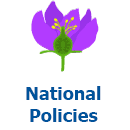An important first step in strengthening gender equity and nutrition outcomes involves having reliable methods of measurement of current conditions (Ballard et al. 2011). Measurement tools and indicators have been developed and validated for measuring nutrition outcomes (FANTA 2008; FAO and FHI 360 2016) and gender equity (Malapit et al. 2014; Alkire et al. 2013) at international level. Measurement helps to hold implementers accountable for the actions they take towards improving the status of gender equity and/or nutrition outcomes in their target areas.
 Every country has developed, formulated, and decreed national policies related to rural advisory services. Find some examples here. If you are looking for a national policy from a specific country, please use the search function, selecting the category “National policies” and the tag for the country.
Every country has developed, formulated, and decreed national policies related to rural advisory services. Find some examples here. If you are looking for a national policy from a specific country, please use the search function, selecting the category “National policies” and the tag for the country.
Wednesday, 25 April 2018 15:24
Best Practice Tips on Measurement Tools for Gender Equity and Nutrition Impact
Written by Ingrid OliveiraDownload here3895 times downloaded
Published in
Recommendations
Tagged under
Latest from Ingrid Oliveira
- Sustainable Undernutrition Reduction in Ethiopia: Training manual for Health and Agriculture Development Armies
- What Every Extension Worker Should Know - Core Competency Handbook
- Sustainable Nutrition Manual Part 3: Healthy Designs
- Sustainable Nutrition Manual Part 2: Healthy Environments
- Sustainable Nutrition Manual Part 1: Healthy Humans


